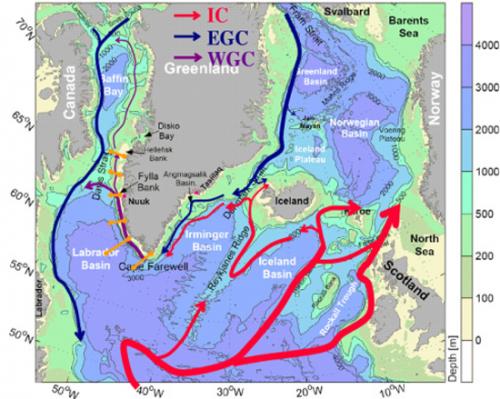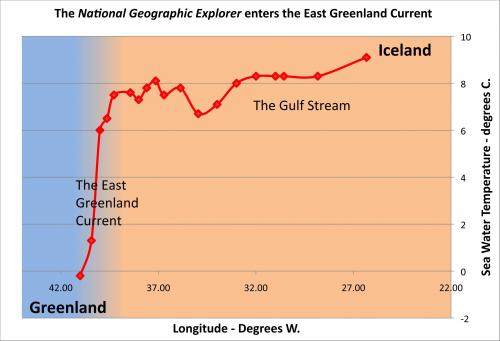Misleading Names: As I mentioned in the previous post, our voyage retraced early Viking pioneers who sailed from Iceland to Greenland (and ultimately to Newfoundland.) Most of my readers will know the irony in these islands' names, as Iceland is fairly green overall while Greenland is covered about 80% by ice. While far from balmy, Iceland owes its warmer climate to the Gulf Stream and its northern extension, the North Atlantic Drift. Warm water from the tropics works its way up the East Coast of the United states before crossing the North Atlantic Ocean, heading for Great Britain and Scandinavia. A fork of this warm surface current known as the Irminger Current envelops Iceland, keeping its coastal waters unfrozen year-round despite its position abutting the Arctic Circle.
Meanwhile, Greenland is hemmed in by the East Greenland Current, which brings cold water from the Arctic Ocean southward along its eastern shores along with pack ice and icebergs calved along the coast. In consequence, even the southernmost tip of Greenland has a colder climate than its more northerly neighbor, Iceland. The cold West Greenland Current flows back north along the west coast, completing the surround of Greenland by cold currents (its northern shores face the Arctic Ocean.)
In the map below, note the North Atlantic Drift and Irminger Current branches as red lines. The East Greenland Current is represented in blue. The West Greenland Current is shown in purple. More about these currents and the map can be found at the Greenland Institute of Natural Resources.

TODAY'S JOURNAL:
As we crossed the Denmark Strait from Iceland to Greenland on 21 July and into the morning of 22 July, naturalist (Steve Maclean](http://www.expeditions.com/why-us/expedition-team/staff-bios/STEVE-MacLEAN/) had the officer of the watch record sea surface temperatures along with our coordinates as we progressed westward at about 64 to 63 degrees north latitude. We were looking for the convergence between the relatively warm Irminger Current and the chilly East Greenland Current. As the graph below shows, the contact was pretty abrupt!

Can you see the longitude where we crossed into the East Greenland Current? What other signs do you think we had demonstrating that we had reached the East Greenland Current besides the surface temperature plunge? Make a prediction before watching the short clip below.
http://youtu.be/62E3lj_Ypxg
Early on 22 July I was awakened by thumps on the hull of the ship. I had the same experience aboard USCGC Healy in 2010- we had encountered ice! As you can see, the East Greenland Current brought icy, foggy, cold conditions. Also note that most if not all of the ice in this movie is sea ice. You can recognize this melting sea ice by the flat nature of the floes and brash ice, as opposed to the blocky glacial ice shown in yesterday's post.
That's all for now! Best- Bill


Comments